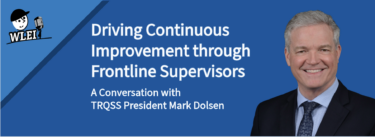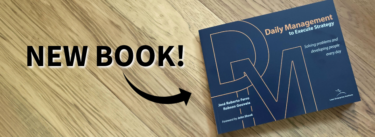Dear Gemba Coach,
How do I spread a lean program? I’ve had good results at my site and my CEO has asked me to spread lean to 30 other sites. How should I go about it?
You’re in a tough spot, no question about it. On the one hand, you’ve got to do what your CEO asks. On the other, what he or she expects might not deliver as he or she expects. How to interpret “spread”? There are two broad ways of looking at this:
- Roll-out: The usual way would be to create a clear model from your experience – what tools you used to get what results – and to implement this model in the other sites.
- Enroll: Convince a group of five other site managers to work together and learn from the way you’ve done it, and then get them to work with five groups of their own.
Roll-out is the classic method of deploying any continuous improvement program. There are four elements to a roll-out program:
- Roadmaps: You must start with clarifying your own experience in terms of what tool helped you to reach what result. This, of course, is a fiction, since activities and results and never one-to-one relationships, reality is too complex, but it usually can be done, such as using 5S to lower accidents, yamazumi to boost productivity, SMED to lower inventory, and so on.
- Objectives: The next step is to size the improvements you’ve achieved on key objectives and get your CEO to commit to these improvements companywide, obtaining the commitment from every other site managers to reach these numbers. Typical objectives would be affect safety, on-time delivery, quality complaints, internal quality, inventory, productivity, etc.
- Continuous Improvement Coaches: You would then form a central office for continuous improvement coaches. Each CI coach would be full-time dedicated for the lean program, and go around the sites conducting workshops on the tools according to the roadmap. To spread the CI office, think of how many workshops you’d need a year to get the other sites off the ground. On the basis of a workshop every couple of month, you’d need 150 workshops done a year. To do the job well, a CI coach can run two workshops a month (with preparation and post-workshop hand-holding), so we’re talking about a central office of six to seven coaches.
- Gemba Visits: You need a commitment from your CEO to visit the lean effort at all 30 sites at a minimum of one visit a year. That’s a visit per week or so — a heavy commitment for many CEOs.
Pros and Cons
The advantage of a roll-out program is that it’s relatively easy to set up. Programs like this have been around for 20 years now, there are enough black belt trained coaches around to recruit a lean office and it can even be farmed out to consultants if need be. Early results are fast and, with a tiny bit of luck, can be spectacular.
The downside is that looking back on these implementation efforts we now see they are mostly “catch-up”. Their merit is to clean out the poor sites and find some obvious things all sites do wrong and fix them. In all the companies I’ve visited over the years, none of these programs have ever instilled a lean culture or continued to deliver results beyond the first three years. Not “a few” not one.
There’s another way to go about spreading lean, which is taking a page out of Toyota’s book. Within Toyota, TPS spread from plant to plant as Taiichi Ohno was promoted to more senior operation roles and recruited more managers to his cause. Then it spread to Toyota’s suppliers through the top.
Supplier CEOs were told (sometimes in no uncertain terms, as described in Lean Thinking) that if they wanted to continue to work with Toyota they were expected to reduce waste in their operations and adopt just-in-time practices to be able to deliver in Toyota’s preferred continuous small batch manner. Toyota would send sensei and engineers to the supplier to help the CEO figure it out.
In the UK when Toyota started operating at Burnaston, it created study groups of five or so supplier senior execs from different companies and, as a team, they would learn TPS in each other’s gembas. Years ago, I’ve seen Toyota spread lean thinking to its dealer network. They first did an assessment to see which suppliers were already good enough to benefit from CI (if not, catch-up was in order), and then proposed coaching to this select group on a voluntary basis.
In your case, the enrolment approach would mean:
- CEO challenge to improve performance: Your CEO would have to start by asking each of the 30 sites to duplicate your performance improvement curve on key indicators. This means taking a period of, say, two years, and asking each site to determine a start point, end point, and leveled monthly project on the key performance indicators mentioned.
- Find 5 or 6 other plant managers ready to learn how you’ve done it: Create a study group of a few other site managers ready to learn, to teach them how to develop a lean culture in their own site. Each site manager would then have to come up with their own improvement plan A3 according to the specifics of their sites.
- Train a few CI engineers to support these plant managers: You would be supporting each member of the group on improvement activities, but hire one or two assistants to join you so that they could learn supporting sites on given activities as well. Activities are mostly tools, but not limited to tools and site-dependent.
- In two years’ time, ask each member of your initial group to create a group of their own, and train five other site managers to improve the way they’ve been taught to. At this point, you’ll have a small team of CI engineers who can help you support activities in a larger group of companies.
- Gemba visits and a lean day: The CEO has to, similarly, visit sites, but also organize a yearly get together of all 30 site managers where a status report is given on the progress of all sites against indicators as a presentation of site by site improvement plans to discuss successes and disappointments.
Change Minds, Not Sites
I realize that many traditional thinking CEOs will balk at the second approach, considering this would take too much time and be too uncertain and people dependent. But let’s face it, this is how lean cultures do spread in companies and in actual fact, experience shows results come much faster this way than in the previous one.
History tends to be very path dependent. The innovative CEOs who turned to lean 20 years ago did so with Toyota veteran consultants, many of whom came from Japan for five-day workshops, for obvious logistics reason. This spread the idea that workshop-based programs could create lean turnarounds. There is so far no evidence that it does, other than when the CEO is directly, hands-on involved, in managing the turnaround with the support of these expert consultants as described in Art Byrne’s great book Lean Turnaround.
The confusion here is that, to be successful, you don’t want to turn around the site, you want to change the site manager’s mind. No two ways about it, company-level results are obtained site manager by site manager, and the result of how they run their own operations, so one way or the other site managers need to be trained to lean thinking. The question is which way: roll-out or enrollment?






